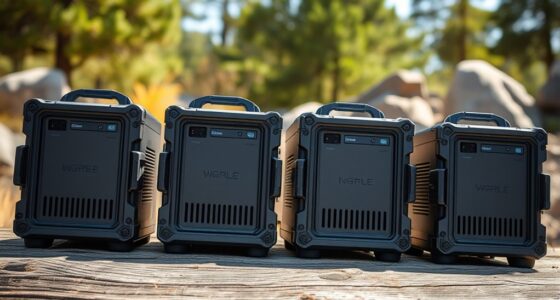If you want top-tier Wi-Fi pentest adapters in 2025, I recommend considering the ALFA models like the AWUS036ACS, AC1900, AXE3000, and AWUS036ACH, which offer excellent range, speed, and support for monitor mode and packet injection. External antennas and long-range capabilities are key for effective security testing. To find the best fit for your needs, you’ll need to weigh compatibility, environment, and power requirements—if you keep exploring, you’ll discover even more options.
Key Takeaways
- Look for Alfa adapters with strong support for monitor mode and packet injection for effective security testing.
- Prioritize models with external high-gain antennas and long-range capabilities for outdoor and extensive network assessments.
- Ensure compatibility with your operating system, including Windows, Linux, and MacOS, and check driver support for Kali Linux.
- Focus on Wi-Fi 6E or tri-band models offering high speeds and better performance in demanding pentesting environments.
- Consider durability and weatherproof features for outdoor security testing and long-distance signal stability.
ALFA Network AWUS036ACS USB Wireless Wi-Fi Adapter
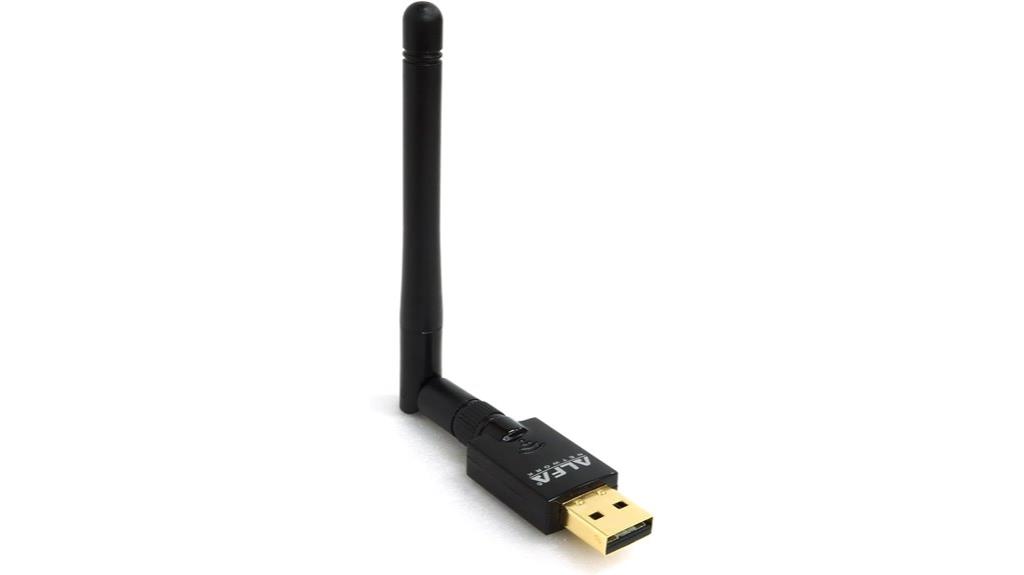
If you’re looking for a reliable dual-band Wi-Fi adapter for network testing or long-range connectivity, the ALFA Network AWUS036ACS stands out. I’ve used it for cybersecurity projects, and its dual-band support with speeds up to 150Mbps on 2.4GHz and 433Mbps on 5GHz makes a real difference. Its external antennas boost coverage, reducing dead zones, perfect for extensive testing. Compact and lightweight, it fits easily on my laptop without blocking ports. Compatibility with Windows, MacOS, and Kali Linux means I can switch platforms seamlessly. While Linux setup can be tricky, with some effort, it’s highly effective for packet injection and monitoring.
Best For: cybersecurity enthusiasts, network testers, and users needing reliable dual-band Wi-Fi for long-range and extensive coverage.
Pros:
- Supports dual-band speeds up to 150Mbps on 2.4GHz and 433Mbps on 5GHz, ensuring fast and stable connections.
- Equipped with high-sensitivity external antennas for extended coverage and reduced dead zones.
- Compact, lightweight design that is portable and easy to use on various platforms including Windows, MacOS, and Kali Linux.
Cons:
- Linux setup can be complex, often requiring third-party drivers and technical effort.
- Limited official driver support for newer MacOS versions and Apple M1/M2 chips.
- Compatibility with certain Linux distributions and older Kali Linux versions may be inconsistent, affecting advanced features like packet injection.
ALFA AC1900 WiFi Adapter (TAA Compliant)
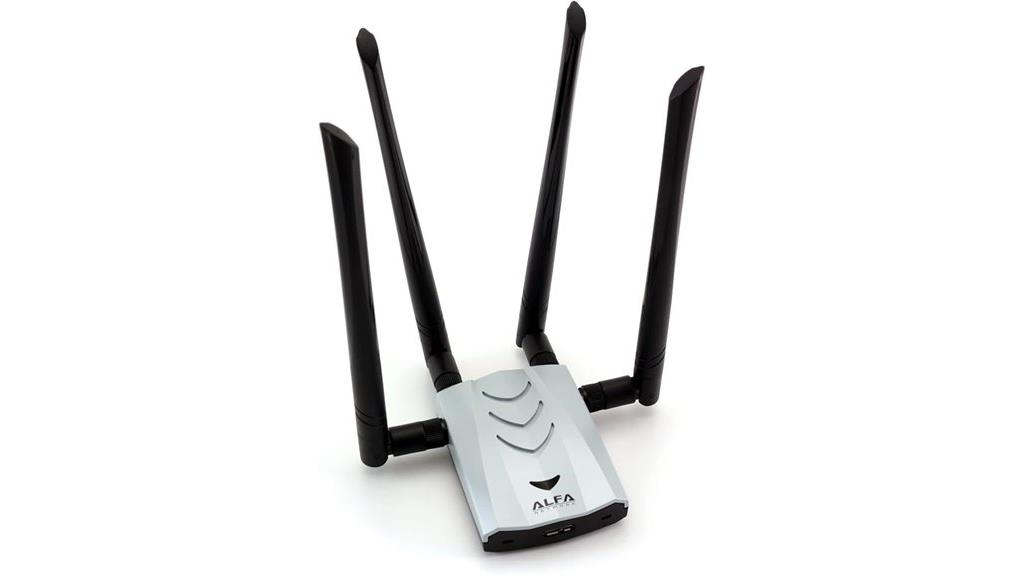
The ALFA AC1900 WiFi Adapter stands out as an excellent choice for security professionals and advanced users who need reliable, high-speed connectivity for pentesting tasks. It delivers up to 1900 Mbps on dual-band Wi-Fi, supported by four external 5dBi antennas for extended range. Its USB 3.0 interface guarantees fast data transfer, while its long-range capabilities allow detection of networks in challenging environments. Compatible with Windows 11, XP, and Linux Mint, it’s suitable for demanding security work—even in outdoor or obstacle-rich settings. Although driver setup can be tricky, especially on Linux, its durability and monitor mode support make it a top-tier tool for professional testing.
Best For: security professionals, advanced users, and pentesters seeking high-speed, long-range Wi-Fi connectivity with monitor mode capabilities.
Pros:
- Supports up to 1900 Mbps on dual-band Wi-Fi with four external antennas for extended range
- Compatible with Windows 11, XP, and Linux Mint, supporting monitor mode for security testing
- Durable build quality and high performance suitable for demanding environments
Cons:
- Driver installation can be complex and challenging, especially on Linux systems
- Bulkiness due to high-performance design may be inconvenient for portable use
- Outdated quick-start guide and inconsistent driver support across platforms
ALFA AWUS036AXML WiFi 6E USB 3.0 Adapter (AXE3000)

Looking for a Wi-Fi adapter that delivers lightning-fast speeds and supports cutting-edge Wi-Fi 6E technology? The ALFA AWUS036AXML is a tri-band USB 3.0 adapter supporting 2.4 GHz, 5 GHz, and 6 GHz bands with speeds up to 3 Gbps. Equipped with a Mediatek chipset, it excels in high throughput, gaming, and streaming. Its detachable 5 dBi antennas ensure strong signals over long distances, even through walls. Compatible with Windows, Linux, and Raspberry Pi OS, it also supports monitor mode and packet injection for advanced testing. Although driver issues can occur, its performance and range make it a top choice for demanding network tasks.
Best For: users seeking high-speed, long-range Wi-Fi 6E connectivity for gaming, streaming, and advanced networking tasks across multiple devices.
Pros:
- Supports tri-band WiFi 6E with speeds up to 3 Gbps for fast, reliable connections
- Detachable high-gain antennas enhance long-distance signal strength and stability
- Compatible with Windows, Linux, and Raspberry Pi OS, supporting advanced features like monitor mode and packet injection
Cons:
- Driver bugs and compatibility issues may require manual troubleshooting on some systems
- Bluetooth functionality may be defective or unstable in certain configurations
- Requires WiFi 6E routers to access the 6 GHz band, limiting use with older network hardware
ALFA Network AWUS036ACM USB Wireless Wi-Fi Adapter
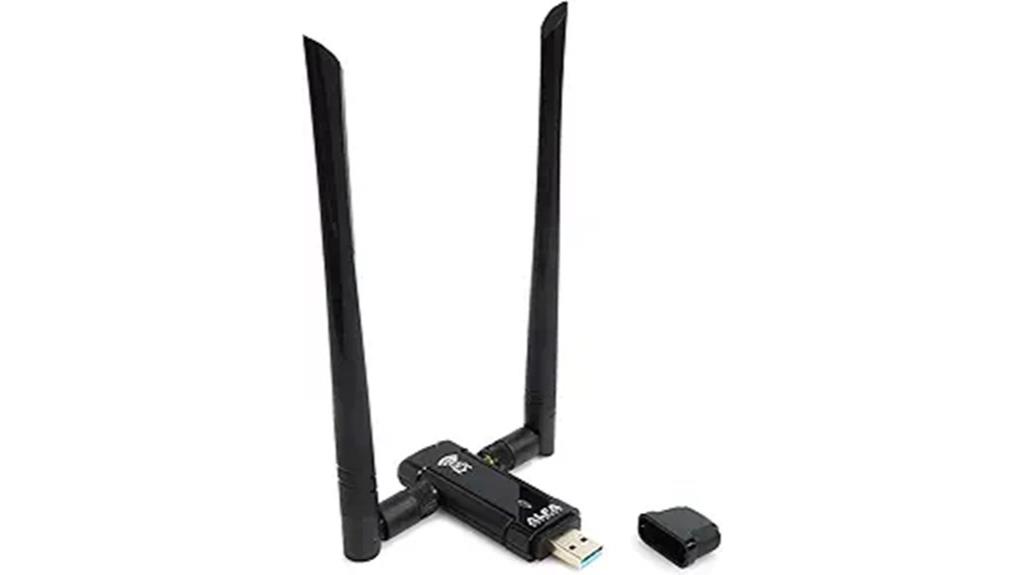
For security professionals and enthusiasts seeking reliable long-range Wi-Fi testing, the ALFA Network AWUS036ACM USB Wireless Adapter stands out with its dual-band AC1200 support and external high-gain antennas. It supports 2.4GHz (300Mbps) and 5GHz (867Mbps), utilizing 802.11ac technology for fast, stable connections. Its external antennas enhance coverage at greater distances, ideal for pentesting and traffic capture. Compatible with Windows, Linux, and older macOS versions, it supports monitor mode and packet injection, making it perfect for Wi-Fi auditing. The compact design, USB 3.0 cradle, and broad OS support make it a versatile, reliable tool for long-range security assessments.
Best For: security professionals, penetration testers, and Wi-Fi enthusiasts needing reliable long-range, dual-band Wi-Fi testing and security auditing capabilities.
Pros:
- Supports dual-band AC1200 speeds with 2.4GHz and 5GHz frequencies for versatile performance
- Compatible with Windows, Linux, and older macOS versions, supporting monitor mode and packet injection
- External high-gain antennas and USB 3.0 cradle enhance long-distance coverage and signal stability
Cons:
- Limited support for newer macOS versions beyond 10.15 and incompatibility with M1/M2 chips
- Potential electrical interference when plugged directly into USB ports, requiring hubs or repositioning
- Some counterfeit units with different chipsets (e.g., RTL8812AU) may lack Linux support and monitor mode functionality
Alfa AWUS036ACHM 802.11ac WiFi Range Boost USB Adapter
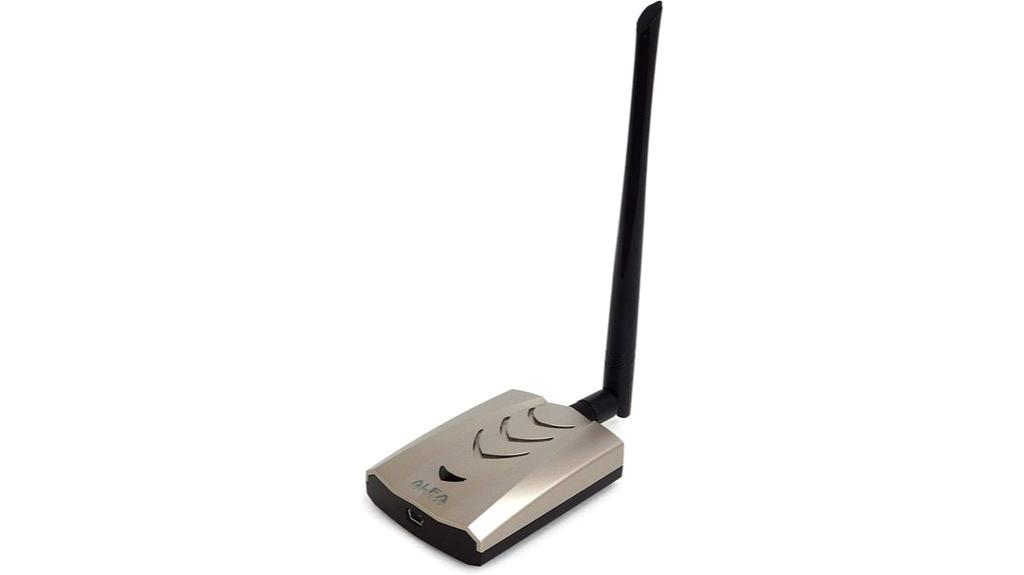
If you’re serious about Wi-Fi pentesting or network analysis, the Alfa AWUS036ACHM stands out as a top choice thanks to its powerful high-gain antenna and support for monitor mode. This high-gain USB adapter supports IEEE 802.11ac, operating on both 2.4 GHz and 5 GHz bands with impressive data rates—up to 150 Mbps and 433 Mbps, respectively. It’s compatible with Windows, Linux, and MacOSX (up to 10.14), and works seamlessly with Kali Linux and Raspberry Pi. Its excellent range of around 80 meters and plug-and-play setup make it ideal for capturing signals, extending Wi-Fi coverage, and performing thorough wireless assessments.
Best For: Wi-Fi pentesters, network analysts, and enthusiasts seeking long-range, high-gain wireless monitoring and auditing capabilities across multiple operating systems.
Pros:
- Supports monitor mode and packet injection, ideal for cybersecurity testing.
- Excellent long-range performance with high-gain detachable antenna.
- Compatible with Windows, Linux, and MacOSX (up to 10.14), with plug-and-play setup in many cases.
Cons:
- Not supported on M1/M2 Mac chipsets or beyond MacOS 10.14.
- Signal strength and range can vary between units, and some users report defective units.
- Does not support MacOS beyond 10.15 or newer Apple Silicon devices.
Alfa Dual-Band AC1200 Wireless USB Wi-Fi Adapter with External Antennas
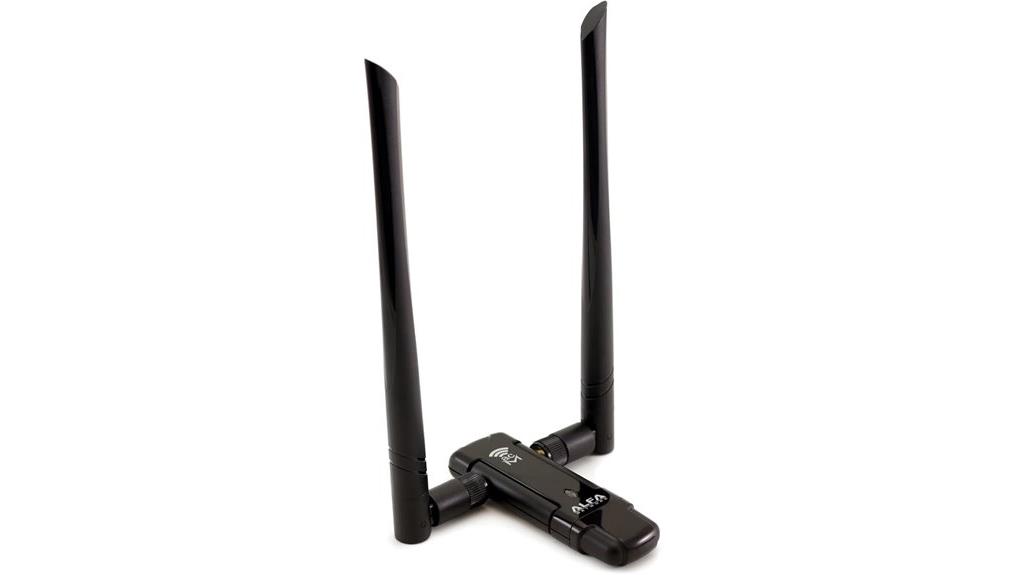
The Alfa Dual-Band AC1200 Wireless USB Wi-Fi Adapter with External Antennas stands out as an excellent choice for those needing long-range, high-speed wireless connectivity. Its dual-band support (2.4GHz/5GHz) and speeds up to 867Mbps on AC networks provide reliable, fast data transfer suitable for streaming and large file sharing. The removable 5dBi antennas can be upgraded for extended range, even outdoors or over water. Compact and portable, it works with multiple OSes, though driver setup can be tricky on some systems. Overall, it offers impressive versatility, making it ideal for pentesting and demanding network environments.
Best For: users seeking a portable, high-speed Wi-Fi adapter with long-range capabilities suitable for streaming, large file transfers, and outdoor or challenging environments.
Pros:
- Supports dual-band 2.4GHz/5GHz with speeds up to 867Mbps on AC networks and 300Mbps on N networks
- Removable 5dBi antennas for upgraded range and signal quality, suitable for outdoor or marine use
- Compact, lightweight design with USB 3.0 support for fast data transfer and easy portability
Cons:
- USB 2.0 base can limit maximum throughput without using a USB 3.0 extension cable or hub
- Driver installation and utility support may be challenging on some newer operating systems like Windows 10
- Limited standalone utility software support and potential driver compatibility issues across different OSes
ALFA Network AWUS036AC Dual-Band USB Wi-Fi Adapter
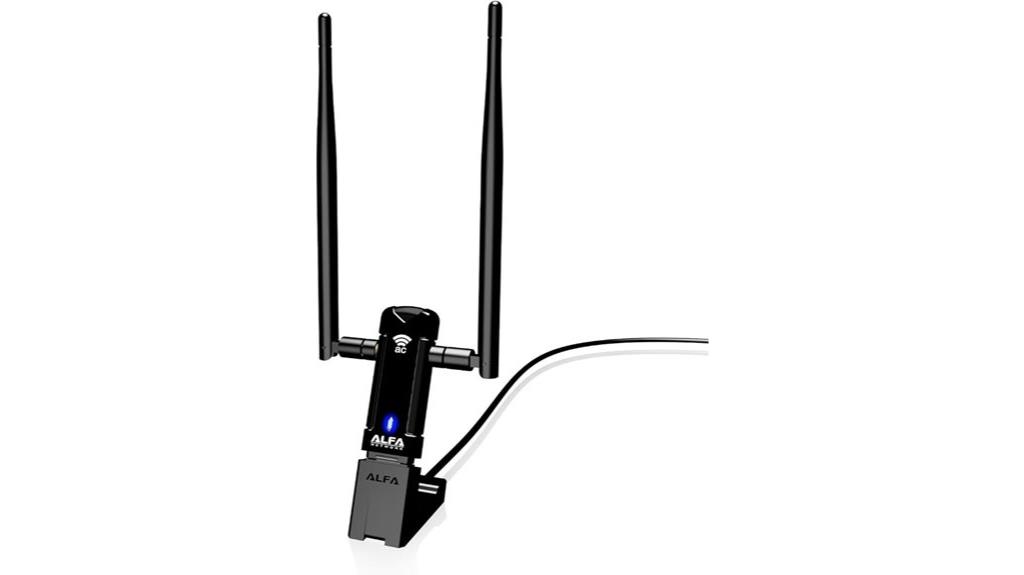
Looking for a reliable dual-band Wi-Fi adapter that can handle both everyday browsing and advanced security testing? The ALFA Network AWUS036AC is an excellent choice. It offers AC1200 speeds, with up to 300Mbps on 2.4GHz and 867Mbps on 5GHz, supported by high-gain external antennas for extended range. Compatible with Windows, MacOS, and Kali Linux, it’s known for its stable connections and long-range coverage—up to 45 feet through walls. While it’s easy to set up, some users may need to install drivers for Kali Linux, and it doesn’t support monitor mode on Windows. Overall, it’s a versatile adapter for security pros and casual users alike.
Best For: users seeking a high-performance, long-range dual-band Wi-Fi adapter for everyday internet use or advanced security testing.
Pros:
- Supports AC1200 speeds with dual-band performance for versatile connectivity.
- High-gain external antennas enhance signal strength and coverage up to 45 feet through walls.
- Compatible with multiple operating systems, including Windows, MacOS, and Kali Linux, with easy plug-and-play setup.
Cons:
- May require driver installation and configuration on Kali Linux and other OSes.
- Does not support monitor mode on Windows, limiting certain security testing capabilities.
- Lacks a carrying case and may have some stability issues with the base or driver setup in certain environments.
BrosTrend AC1200 WiFi to Ethernet Adapter
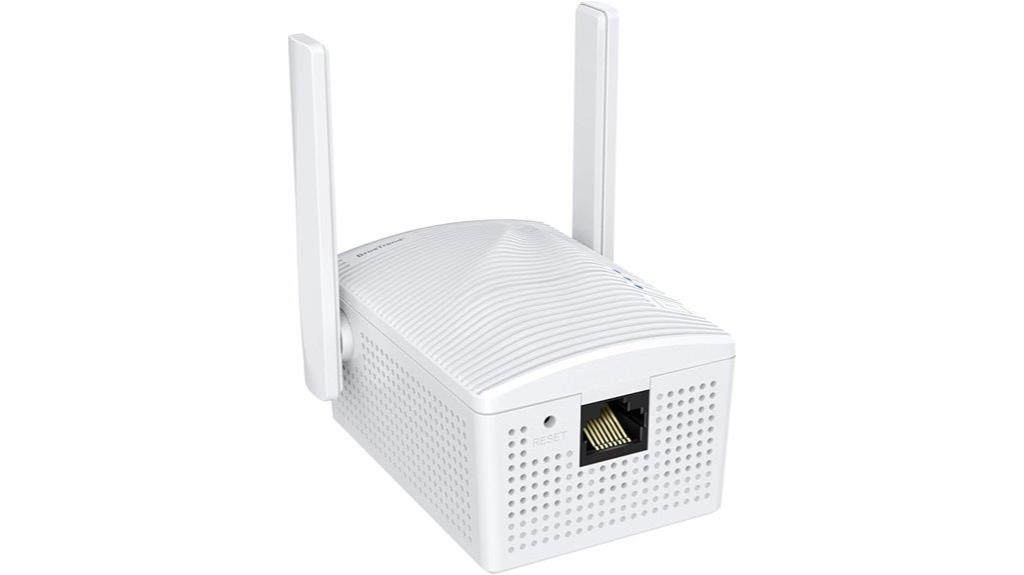
For those seeking a reliable way to connect wired devices to Wi-Fi networks without complexity, the BrosTrend AC1200 WiFi to Ethernet Adapter stands out. It transforms wired Ethernet devices into wireless-enabled ones, supporting speeds up to 1200Mbps—867Mbps on 5GHz and 300Mbps on 2.4GHz—ideal for streaming and gaming. Compatible with all Ethernet-enabled devices and any Wi-Fi router, it works seamlessly with Windows, macOS, Linux, Android, and Chrome OS without drivers. Its dual-band operation, external antennas, and easy setup via WPS make it a versatile, user-friendly solution for extending Wi-Fi range or converting Ethernet devices into wireless ones effortlessly.
Best For: users seeking an easy, reliable way to connect wired devices to Wi-Fi networks without complicated setup or additional hardware.
Pros:
- Supports high speeds up to 1200Mbps, ideal for streaming and gaming
- Compatible with all Ethernet-enabled devices and major operating systems without drivers
- Easy to set up via WPS, making it user-friendly even for non-tech users
Cons:
- Some users report spotty Wi-Fi reception or connection issues with certain devices
- Insecure default settings may require additional configuration for security
- Limited advanced customization options for network settings
ALFA AWUS036ACH Dual-Band AC1200 Wireless Wi-Fi Adapter with External Antennas

If you need a Wi-Fi adapter that combines high-speed performance with long-range capabilities, the ALFA AWUS036ACH Dual-Band AC1200 stands out as an excellent choice. It offers dual-band support, with speeds up to 300Mbps on 2.4GHz and 867Mbps on 5GHz, thanks to 2x 5dBi external antennas that boost signal strength and extend range. Its USB-C interface guarantees fast, reliable connections and portability. Compatible with Windows and Linux, it’s ideal for streaming, gaming, and pentesting. While some users report driver challenges on Linux, its strong signal reception and high-gain antennas make it a popular option for secure network testing and long-distance connections.
Best For: users seeking high-speed, long-range Wi-Fi connectivity for streaming, gaming, or network security testing on Windows or Linux systems.
Pros:
- Dual-band support with speeds up to 300Mbps on 2.4GHz and 867Mbps on 5GHz for versatile high-speed connections
- Equipped with 2x 5dBi external antennas, enhancing signal strength and extending Wi-Fi range
- Compact USB-C interface offers portability and reliable, streamlined connectivity
Cons:
- Some users experience driver issues and connectivity instability, especially on Linux systems
- Hardware quality can be inconsistent, with reports of disconnections and driver crashes
- Limited support for macOS beyond version 10.15 and M1/M2 chipsets, reducing compatibility for Apple users
Factors to Consider When Choosing Wi‑Fi Pentest Adapters (ALFA)
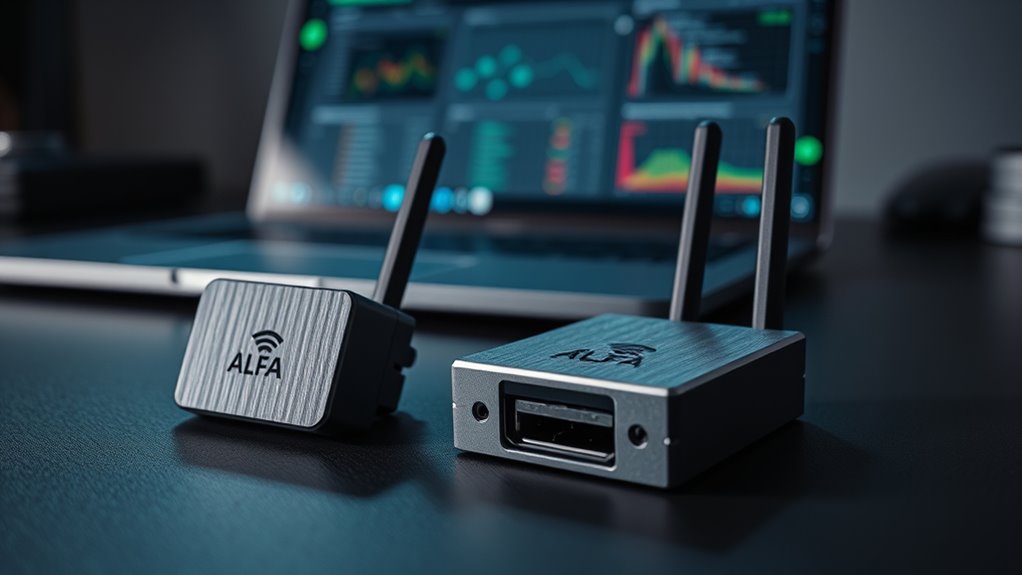
When choosing a Wi-Fi pentest adapter, I focus on factors like compatibility with my OS and support for monitor mode, since these are essential for effective testing. I also consider driver availability, antenna quality, and packet injection capabilities to guarantee reliable performance. Understanding these points helps me select the best tool for my needs.
Compatibility With OS
Choosing a Wi-Fi pentest adapter that supports your operating system is important for smooth and effective security testing. I always check whether the adapter works with my OS version, whether it’s Windows 10, 11, or Linux distributions like Kali Linux. Making certain drivers are available and actively maintained is crucial, especially for Linux users who might need to manually install or compile them. Compatibility with MacOS is also significant, but support can be limited on newer chips like M1 or M2 or beyond MacOS 10.15. I pay attention to whether the adapter supports monitor mode and packet injection on my OS, as these features are essential for thorough Wi-Fi auditing. Compatibility ensures that all tools run flawlessly, saving me time and avoiding frustration during testing.
Support for Monitor Mode
Support for monitor mode is essential for effective Wi-Fi penetration testing because it allows your adapter to capture all wireless traffic in the air, not just packets addressed to it. This capability is fundamental for analyzing network activity and identifying vulnerabilities. However, not all Wi-Fi adapters support monitor mode natively; verifying compatibility with your operating system and drivers is crucial. Chipsets like Realtek RTL8812AU and Atheros AR9271 are known for reliable monitor mode support. Enabling this feature usually requires specific drivers or third-party software, so driver support becomes a key factor. Be aware that some adapters support monitor mode but lack packet injection, which is necessary for advanced tasks like deauthentication attacks. Ensuring your adapter has both features is critical for comprehensive pentesting.
Driver Availability and Support
Selecting a Wi-Fi pentest adapter with reliable driver support is essential for a smooth and effective testing experience. I look for adapters with official or well-supported drivers for my operating system to ensure stability and full functionality. Regular driver updates from the manufacturer are a must, especially for compatibility with the latest Linux and macOS versions. I also verify that the adapter supports monitor mode and packet injection through compatible drivers, as these are critical for pentesting. Some adapters require manual driver compilation or third-party sources, which can complicate setup and affect reliability. I also consider community support, like active projects on GitHub, since troubleshooting and advanced features often depend on active driver development. Good driver support saves time and ensures consistent performance during testing.
Antenna Quality and Range
Have you considered how antenna quality and range can make or break your Wi-Fi pentesting efforts? High-quality external antennas with 5dBi or more gain dramatically boost signal strength and extend your testing reach. Directional antennas, like Yagi or parabolic types, focus signals in specific directions, increasing penetration through obstacles and expanding coverage. Detachable antennas offer flexibility, allowing upgrades to higher-gain or specialized models tailored to your testing environment. Using longer cables or extensions helps position antennas preferably, reducing interference and enhancing reception. Additionally, the overall design and build quality—materials and construction—affect durability and signal stability over long distances. Paying attention to these factors guarantees reliable, far-reaching connections essential for thorough and effective Wi-Fi pentesting.
Packet Injection Capabilities
Antenna quality and range are essential for establishing a solid connection during Wi-Fi pentesting, but the ability to perform effective tests also depends heavily on packet injection capabilities. Packet injection lets adapters send crafted packets to uncover vulnerabilities, making it a critical feature. To do this reliably, the adapter must have compatible hardware, like Realtek RTL8812AU or Atheros AR9271 chipsets, which support injection in most cases. Driver support for monitor mode also plays a key role, as not all drivers enable this feature consistently across operating systems. Many Linux tools, such as Aircrack-ng and Reaver, depend on robust injection capabilities for tasks like deauthentication and handshake capturing. Ensuring your adapter can inject packets efficiently and with minimal packet loss is essential for successful penetration testing.
Power Consumption Needs
Power consumption is a critical factor when choosing Wi-Fi pentest adapters because it directly impacts portability and operational stability. High-performance adapters with advanced features like powerful antennas, monitor mode, and packet injection tend to consume more power, which can reduce battery life and increase heat output. If you’re testing in the field, lower power models are more practical, especially for battery-powered laptops, as they extend operational time. Additionally, consider your device’s power requirements—some adapters need external power supplies or powered USB hubs, particularly when using multiple external antennas or high data throughput. Balancing power needs with performance is essential; higher power consumption often means better signal quality but can compromise portability and device longevity during extended testing.
Device Size and Portability
Choosing the right Wi-Fi pentest adapter often hinges on its size and portability, especially if you’re conducting fieldwork or need to move quickly between locations. Smaller adapters are highly portable, making them easy to carry in a backpack or pocket, perfect for on-the-go assessments. Compact devices typically have integrated antennas, which limit signal range but simplify setup in tight spaces. Larger adapters with external antennas tend to offer better long-range performance but are less convenient for mobile or covert operations. The device size also affects compatibility with your gear, like laptop bags or toolkits. Additionally, lightweight, mini adapters reduce fatigue during long testing sessions, improving comfort and efficiency. Balancing size with performance guarantees you’re prepared for any testing environment.
Long-Range Performance
Long-range performance of Wi-Fi pentest adapters depends heavily on several key factors that can make or break your testing effectiveness. High-gain external antennas, typically 5dBi or higher, are essential for extending signal reach. The type and placement of antennas, along with environmental elements like walls or interference, play pivotal roles in signal quality. Advanced adapters support monitor mode and packet injection over long distances, enabling detailed analysis. With proper directional antennas and line-of-sight conditions, you can achieve indoor ranges up to 80 meters and outdoor distances exceeding 2,000 feet. Additionally, high transmission power and sensitive chipsets are indispensable for maintaining stable, long-distance connections. Considering these factors guarantees you select an adapter capable of reliable, extended-range Wi-Fi testing.
Frequently Asked Questions
How Do Different Wi-Fi Standards Impact Penetration Testing Capabilities?
Different Wi-Fi standards considerably impact my penetration testing capabilities. For instance, Wi-Fi 6 offers higher speeds and better security features, but it can be more complex to analyze. Older standards like 802.11g are easier to test with basic tools. I choose my adapters based on the network’s standard to make certain I can identify vulnerabilities effectively, adapting my approach to meet each standard’s specific challenges and opportunities.
What Are the Best Practices for Securing Wi-Fi Adapters During Testing?
To secure Wi-Fi adapters during testing, I always make certain they’re connected to a trusted, isolated network to prevent leaks. I disable unnecessary services and change default credentials to limit vulnerabilities. Using encryption and VPNs adds extra layers of security. I also keep my firmware updated and monitor traffic for suspicious activity, so I can spot potential threats early. These steps help me keep my testing environment safe and secure.
How Does Antenna Design Influence Testing Range and Accuracy?
Antenna design greatly impacts testing range and accuracy. I’ve found that directional antennas focus signal strength in specific directions, boosting range and precision during tests. Omnidirectional antennas, on the other hand, spread signals evenly, providing broader coverage but less focus. Choosing the right design depends on your needs—directional for targeted testing, omnidirectional for general coverage. Proper antenna selection guarantees more reliable results and better assessment of network security.
Are There Compatibility Issues With Specific Operating Systems?
Compatibility issues can arise with certain operating systems when using Wi-Fi pentest adapters like ALFA. I’ve found that some models work seamlessly with Linux, especially Kali Linux, but may have limited support or require extra drivers for Windows or macOS. To avoid headaches, I always check the adapter’s compatibility list and community feedback before purchasing, ensuring smooth integration with my preferred OS.
How Often Should Firmware and Drivers Be Updated for Optimal Performance?
I recommend updating firmware and drivers at least once every three months to guarantee peak performance. Studies show that outdated firmware can cause up to 30% slower connection speeds and security vulnerabilities. Regular updates fix bugs, improve compatibility, and enhance security. I personally check for updates monthly, especially before any critical testing, to keep my equipment running smoothly and securely. Staying current helps me stay ahead of potential issues and maximizes my testing capabilities.
Conclusion
When choosing the best Wi-Fi pentest adapter, consider compatibility, performance, and security features. Focus on reliability, speed, and ease of use to guarantee thorough testing. Prioritize adapters that fit your specific needs, whether it’s range, bandwidth, or advanced protocols. By selecting the right tool, you’ll enhance your testing capabilities, improve network security, and stay ahead of potential vulnerabilities. Ultimately, the right adapter empowers you to test confidently, analyze thoroughly, and secure your network effectively.



